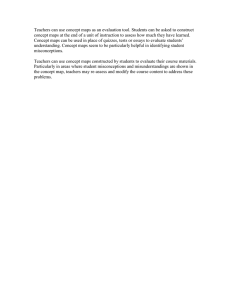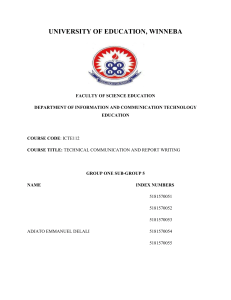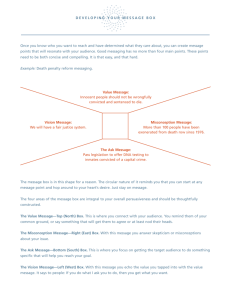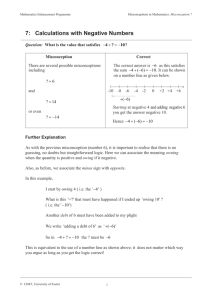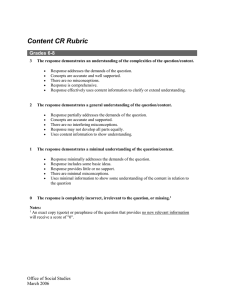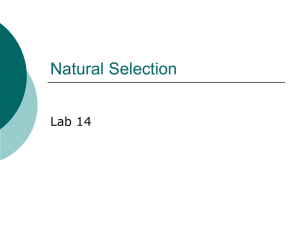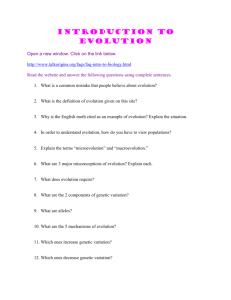Introduction to Evolution: Natural Selection & Mechanisms
advertisement
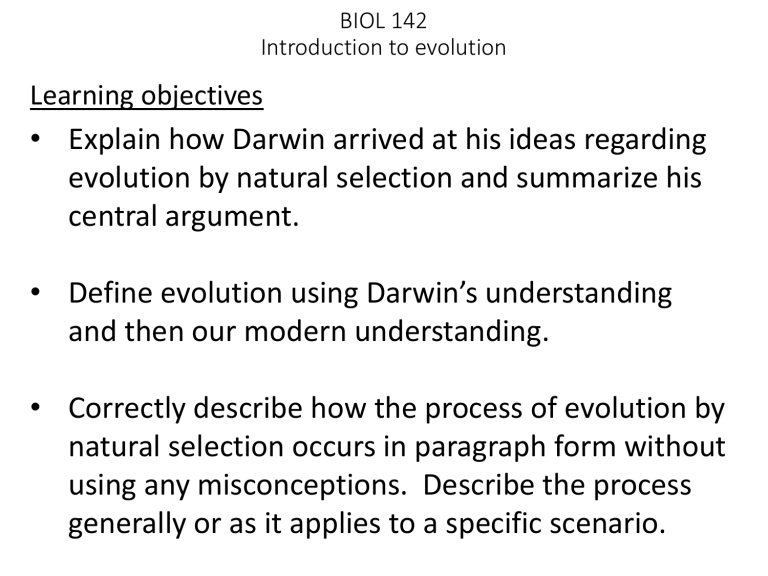
BIOL 142 Introduction to evolution Learning objectives • Explain how Darwin arrived at his ideas regarding evolution by natural selection and summarize his central argument. • Define evolution using Darwin’s understanding and then our modern understanding. • Correctly describe how the process of evolution by natural selection occurs in paragraph form without using any misconceptions. Describe the process generally or as it applies to a specific scenario. About me… Dr. Krieg Complete pre-semester survey How do organisms meet the challenges of life? Introduction to Evolution “descent with modification” Darwin Wallace Introduction to Evolution “descent with modification” “modern synthesis” Mendelian genetics + Darwinian evolution 1930s/1940s Introduction to Evolution by Natural Selection Phenotypes in a population tend to vary Introduction to Evolution by Natural Selection All species have capacity to produce more offspring than the environment can support Introduction to Evolution by Natural Selection If an individual has a trait that makes it more likely to survive and reproduce, it will leave more offspring than others Introduction to Evolution by Natural Selection Over generations, these favorable traits will be more common in the population Why it matters Why it matters Why it matters The human ecological footprint can be felt on 83% of the earth’s land surface Why it matters BIOL 142 Requirements of evolution Learning objectives • Define evolution using Darwin’s understanding and then our modern understanding. • Explain the requirements of evolution by natural selection. If given an example, determine whether evolution by natural selection has occurred and support your argument by referencing these requirements. Evolution Definition from last class? Change in allele frequencies in a population over generations (book calls microevolution) Allele: one of several alternative versions of a gene Evolution Evolution Requirements of evolution by natural selection 1. Variation must exist in the traits in a population “raw material” of natural selection Requirements of evolution by natural selection 1. Variation must exist in the traits in a population 2. Variation must be heritable Requirements of evolution by natural selection 1. Variation must exist in the traits in a population 2. Variation must be heritable 3. Heritable variation must be reflected in the phenotype Requirements of evolution by natural selection 1. Variation must exist in the traits in a population 2. Variation must be heritable 3. Heritable variation must be reflected in the phenotype 4. Individuals with certain variants must be better at surviving and reproducing than others (have higher fitness) Evolution Requirements of evolution by natural selection Products of evolution by NS are Adaptations (inherited characteristics that probability of survival and reproduction) Adaptations are context-dependent Adaptations are not perfect BIOL 142 Common misconceptions of evol by NS Learning objectives • Identify common misconceptions about evolution by natural selection. Explain why these misconceptions are incorrect. • Correctly describe how the process of evolution by natural selection occurs in paragraph form without using any misconceptions. Describe the process generally or as it applies to a specific scenario. Common misconceptions of evolution by NS Misconception: Evolutionary fitness = physical fitness Common misconceptions of evolution by NS Misconception: Individual organisms change because they “need” to, populations change “for the good of the species” Individuals already have their genetic characters at birth Selection does not have a will or agency Common misconceptions of evolution by NS Misconception: “Evolution happens so a species can survive.” Does this reflect a misconception? Common misconceptions of evolution by NS Misconception: “The population changed in order to survive.” Does this reflect a misconception? Common misconceptions of evolution by NS Misconception: Organisms/species can change themselves Individuals already have their genetic characters at birth Common misconceptions of evolution by NS Misconception: Individuals change Population changes (allele frequencies) Common misconceptions of evolution by NS Misconception: Evolution always occurs slowly Rapid evolution happens! What determines speed: • size of benefit chr offers • generation time of org Common misconceptions of evolution by NS Misconception: Evolution is goal oriented or can see what’s helpful for the future For character to spread through evolution by NS, it must provide fitness benefit in the current environment Common misconceptions of evolution by NS Misconception: Evolution produces perfectly engineered organisms Evolution always produces more complexity Survival of the “fit-enough” BIOL 142 Other mechanisms of evolution Learning objectives • Distinguish between evolution by natural selection and evolution through other mechanisms (genetic drift, gene flow). • Explain how and why genetic drift can lead to nonadaptive changes using several different examples. Other mechanisms of evolution Change in allele frequencies in a population over generations Genetic drift 1. Variation must exist in the trait 2. Variation must be heritable 3. Heritable variation must be reflected in the phenotype 4. By random chance some variants leave more offspring in the next generation Other mechanisms of evolution Genetic drift Other mechanisms of evolution: Genetic Drift Phenomena that make drift more likely: Bottleneck effect Other mechanisms of evolution Phenomena that make drift more likely: Bottleneck effect Other mechanisms of evolution Phenomena that make drift more likely: Founder effect Other mechanisms of evolution Phenomena that make drift more likely: Founder effect Retinis pigmentosa frequency gen pop: 1 in 4,000 Frequency on Tristan da Cunha: 1 in 58 Other mechanisms of evolution Phenomena that make drift more likely: Founder effect Retinis pigmentosa frequency gen pop: 1 in 4,000 Frequency on Tristan da Cunha: 1 in 58 Ask your self while reading: Why is genetic drift more likely to lead to nonadaptive changes? Other mechanisms of evolution Change in allele frequencies in a population over generations Gene flow New alleles enter/leave pop as individuals immigrate/emigrate Other mechanisms of evolution Gene flow Other mechanisms of evolution Gene flow A = lots of bands, D = no bands Other mechanisms of evolution Gene flow Can introduce new alleles that can be acted on by natural selection
